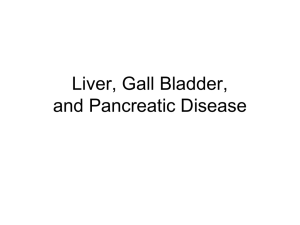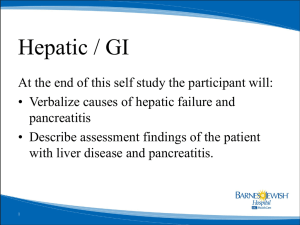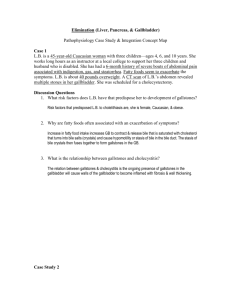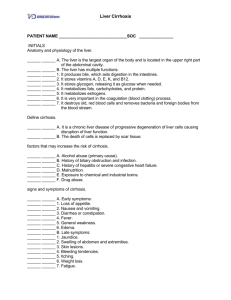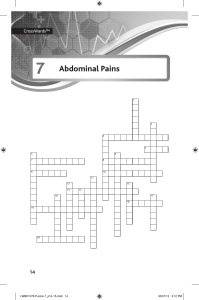GI Assessment: Diagnosis and Case Studies PowerPoint
advertisement
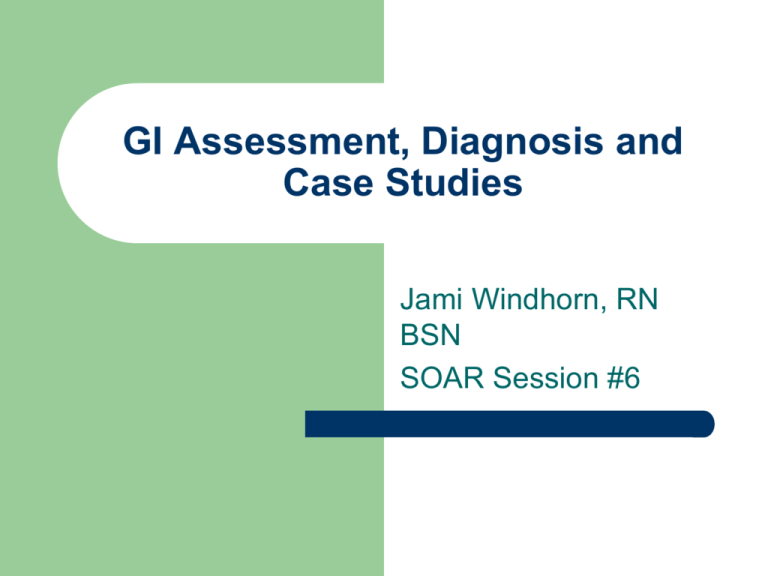
GI Assessment, Diagnosis and Case Studies Jami Windhorn, RN BSN SOAR Session #6 Abdominal Assessment 4 Quadrants: * Right Upper * Right Lower * Left Upper * Left Lower Abdominal Assessment 9 Regions: Abdominal Assessment Right Upper Quadrant Organs Liver Gallbladder Duodenum Pancreas Head Right Kidney and Adrenal Right Lower Quadrant Organs Cecum Appendix Right Ovary and Fallopian Tube Left Upper Quadrant Organs Stomach Spleen Pancreas Left Kidney and Adrenal Left Lower Quadrant Organs Sigmoid Colon Left Ovary and Fallopian Tube Nursing Assessment - History Dysphagia Weight Gain or Loss Pain Appetite Nausea/Vomiting Diarrhea/Constipation Past Abdominal Problems Nursing Assessment - History Allergies Current Medications Alcohol/Drugs/Tobacco Use Nutrition Exposure to Infectious Disease Stress Pregnant Nursing Assessment General Observation Inspection Auscultation Percussion Palpation Preparing for Exam Provide Privacy Expose the Abdomen Empty Bladder Place Patient Supine with at Side Warm Hands and Stethoscope Assess Painful Areas Last Inspection Overall Observation Flat? Distended? Symmetrical? Skin Color Scars Visible Pulsations Peristalsis Inspection Abnormalities Distention Hepatomegaly Ascites Inspection Abnormalities Enlarged Gallbladder Umbilical Hernia Inspection Abnormalities Cullen’s Sign * Bluish sign at umbilicus is a sign of bleeding in the peritoneum Inspection Abnormalities Grey Turner’s Sign * Bruising on the flanks indicating a retroperitoneal bleeding Inspection Abnormalities Spider Angiomas: * Indicative of Liver Disease – Cirrhosis Inspection Abnormalities Visible Peristalsis Video Nursing Assessment - Auscultation Always listen before you touch!! Bowel sounds mean the GI tract is working Hyper? Hypo? Listen for 5 minutes before documenting no bowel sounds Sounds Nursing Assessment - Percussion Tympany – Sound of air in the gut Resonance – Lower pitched and hollow Dullness – Flat sound without echoes: Liver, Spleen, Ascites, Distended Bladder Percussion Technique Nursing Assessment - Palpation Light Palpation – Depress 1 cm Deep Palpation – Depress 5-8 cm Always assess tender areas last Watch patient’s expression during palpation Palpation Techniques Assessing the Liver Palpation Abnormalities Tenderness Masses Firmness or Muscle Rigidity ** Could be a sign of intraabdominal bleeding – Stop Palpation!! ** GI Diagnosis Pancreas A large gland located behind the stomach and next to the duodenum 2 Purposes: * Secretes digestive enzymes into small intestine for digestion of carbohydrates, proteins and fats * Releases insulin and glucagon to help regulate blood glucose metabolism Pancreatitis 2 Forms: * Acute: Sudden inflammation over a short period of time * Chronic: Commonly follows acute pancreatitis due to ongoing inflammation of the pancreas Acute Pancreatitis Causes: * Gallstones • Heavy Alcohol Use • Medications • Infections • Trauma • Metabolic Disorders • Surgery • Up to 30% of cases have an unknown cause Acute Pancreatitis Symptoms: * Upper abdominal pain, made worse with eating * Swollen abdomen * Nausea and Vomiting * Fever * Tachycardia Acute Pancreatitis Diagnosis: * Amylase and Lipase levels * Ultrasound * CT Scan * Glucose Tolerance Test * Pancreatic Function Test Acute Pancreatitis Treatment: * IV Fluids * Pain Meds * Removal of Gallbladder * Antibiotics Chronic Pancreatitis Causes: * Prolonged Alcohol Use * Acute Pancreatitis * Gallstones * Cystic Fibrosis * Hereditary disorders of the Pancreas Chronic Pancreatitis Symptoms: * Constant pain in upper abdomen radiating to the back * Weight loss caused by poor nutrient absorption * Diabetes Chronic Pancreatitis Diagnosis: * Previous acute pancreatitis * Amylase and Lipase levels * Pancreatic Function Tests * CT scan * Ultrasound Chronic Pancreatitis Treatment: * Pain Meds * Pancreatic Enzymes * Insulin * Low-fat diet * Surgery * Stop drinking and smoking Normal Pancreatic CT Acute Pancreatitis CT Chronic Pancreatitis with Calcifications Liver Important in protein production and blood clotting to cholesterol, glucose and iron metabolism. Liver is the largest internal organ and largest gland in the body Weighs approx 3-3.5 pounds Liver, Gallbladder and Pancreas Liver Disease The broad term "liver disease" applies to many diseases and disorders that cause the liver to function improperly or stop functioning altogether Liver Diseases Hepatitis B Hepatitis C Long term alcohol use Cirrhosis Malnutrition Acute liver failure from medications Liver Failure Symptoms: * Nausea * Loss of appetite * Fatigue * Jaundice * Bleeding easily * Swollen abdomen Liver Failure Treatments: * Reverse medication cause Ex. Tylenol overdose, acetylcysteine * Supportive care for viruses * Liver transplant Liver Disease Prevention Hepatitis B Vaccine series Well balanced diet Limit alcohol consumption Good hygiene and hand washing Protect yourself from accidental needlesticks Don’t share razors or toothbrushes Gastritis Gastritis is an inflammation, irritation, or erosion of the lining of the stomach Can be acute or chronic Caused by H pylori, infections, bile reflux Diagnosed by upper GI, labs, fecal occult blood test Gastritis Medications * Antacids * Proton Pump Inhibitors * Histamine Blockers * Carafate * Mucosal Barrier Enhancers * Penicillin **See Treating Ulcer Disease and Gastritis Handout** GI Bleed Describes any form of bleeding in the GI tract, from the pharynx to the rectum. The degree of bleeding can range from nearly undetectable to acute, massive, lifethreatening bleeding. A good history and exam can help determine the seriousness and the cause GI Bleed Causes: * Peptic Ulcers * Erosive Gastritis/Esophagitis * Chronic Liver Disease * Forceful Vomiting * Stress Gastritis * Long-term NSAID Use GI Bleed Symptoms: * Hematemesis * Syncope * Epigastric/Abdominal Pain * Dysphagia * Heartburn * Jaundice GI Bleed Diagnosis: * CBC, BMP, Type and Cross, Ca level * Orthostatic blood pressures * Chest X-ray * Endoscopy * NG tube and gastric lavage * CT scan Bleeding Ulcer GI Bleed Management: * Maintain the airway * 1 or 2 large bore PIVs * Replace blood loss with NS, D5.45, LR * Foley * Surgical Repair GI Bleed Medications: * Antacids * Proton Pump Inhibitors * Histamine Blockers * Carafate * Mucosal Barrier Enhancers * Penicillins ** See “Treating Ulcer Disease and Gastritis” Handout** Clinical Signs of Blood Loss <1000ml 1000-1500ml 1500-2000ml >2000ml ** See Handout ** GI Case Study #1 Mr B is a 57-year-old man who was admitted yesterday after starting to pass black stools. He has a two-day history of severe stomach pains and has suffered on and off with indigestion for some months. He is a life-long smoker, with mild chronic cardiac failure (CCF) for which he has been taking enalapril 5 mg BID for 2 years. He also recently started taking naproxen 500 mg BID for arthritis. Yesterday his hemoglobin was reported as 10.3 g/dL (range12–18 g/dL), platelets 162 × 109/L (range 150–450 × 109/L), INR 1.1 (range 0.8–1.2) He was mildly tachycardic (87 bpm) and had a slightly low blood pressure of 115/77 mmHg and was given 1.5 L of saline. He has just returned from endoscopy this morning and has been newly diagnosed as having a bleeding duodenal ulcer. He has been written up for his usual medication for tomorrow if he is eating and drinking again. GI Case Study #1 What risk factors does he have for a bleeding ulcer? Has his treatment been appropriate so far? Why? Any tests he may still need? Should he be given a proton pump inhibitor? What discharge teaching should he get? GI Case Study #2 Mrs. Miller See Handout GI Case Study #2 What is the difference between acute and chronic pancreatitis? Define signs and symptoms of acute pancreatitis? What are the causes of pancreatitis? How will the spironolactone be given thru the NG? What type of diet will Mrs. Miller be advanced to next? Besides the KUB and labs, what other tests should Mrs. Miller get done? GI Case Study #3 Mr. W, 59 years old, is divorced and unemployed. He was admitted to an acute medical ward at the hospital presenting with general malaise, a grossly distended abdomen, swollen ankles and jaundice. It was also noted that he smelt of alcohol and was showing signs of alcohol withdrawal GI Case Study #3 What is cirrhosis of the liver? What are causes of cirrhosis? What are signs and symptoms of cirrhosis? What labs/tests help to diagnose Cirrhosis?
